Thursday 2 March, 2006, 09:48 - Spectrum Management
Posted by Administrator
Posted by Administrator
 Spectrum administrations or radio regulators, whatever phrase you care to pick, tend to be staffed by enthusiastic and intelligent staff; after all, it's a complex field this radio malarkey. However, what most staff lack (and most would readily admit to) is any real experience or expertise in the radio spectrum itself. Why is this? Well, other than working for a regulator or a radio user (such as a mobile or broadcasting company) there are very few ways to gain any real radio skills. For example, most degrees in technology of one kind or another will cover 'telecommunications' and may even stray into 'electromagnetism' but few, if any, give any real chance to learn about the radio spectrum, how it is used and how to manage it. There are various manufacturers who offer training on their suite of spectrum management software and monitoring hardware, which is great if you happen to have their tools, otherwise it would be like learning how to ride a bike and then being given the job as a traffic cop!
Spectrum administrations or radio regulators, whatever phrase you care to pick, tend to be staffed by enthusiastic and intelligent staff; after all, it's a complex field this radio malarkey. However, what most staff lack (and most would readily admit to) is any real experience or expertise in the radio spectrum itself. Why is this? Well, other than working for a regulator or a radio user (such as a mobile or broadcasting company) there are very few ways to gain any real radio skills. For example, most degrees in technology of one kind or another will cover 'telecommunications' and may even stray into 'electromagnetism' but few, if any, give any real chance to learn about the radio spectrum, how it is used and how to manage it. There are various manufacturers who offer training on their suite of spectrum management software and monitoring hardware, which is great if you happen to have their tools, otherwise it would be like learning how to ride a bike and then being given the job as a traffic cop!Step up to the lectern then, various organisations who have put together training courses which can be taken by anyone but are aimed at giving the opportunity to learn about this fascinating subject. That being said, there are not many such organisations: in fact it would seem there are only a small handful in the world!
 The first such organisation is the National Telecommunications and Information Administration (NTIA). The NTIA runs an annual Spectrum Management Training Seminar over a one week period, however this is only open to 'U.S. Government agencies and contractor personnel nominated by Federal agencies'. With only 25 spaces, the course is always over-subscribed so the chance of getting a place is small. Not a great start! However, the NTIA, together with the United States Telecommuications Training Institute (USTTI) run another annual radio frequency spectrum management course every spring which is open to 'representatives of developing nations', who are sponsored by the U.S. government and thus can attend the course for free!
The first such organisation is the National Telecommunications and Information Administration (NTIA). The NTIA runs an annual Spectrum Management Training Seminar over a one week period, however this is only open to 'U.S. Government agencies and contractor personnel nominated by Federal agencies'. With only 25 spaces, the course is always over-subscribed so the chance of getting a place is small. Not a great start! However, the NTIA, together with the United States Telecommuications Training Institute (USTTI) run another annual radio frequency spectrum management course every spring which is open to 'representatives of developing nations', who are sponsored by the U.S. government and thus can attend the course for free! The USTTI (which is a joint U.S. Government and industry sponsored, not-for-profit organisation) also run a number of courses of varying lengths covering spectrum management and spectrum monitoring, each of which is sponsored by a manufacturer (such as Agilent, TCI or Rohde & Schwarz). The USTTI courses are provided for free, whilst participants have to cover their travel and subsistence costs, and applications have to be made 16 weeks (4 months) in advance. Nothing in life is every truly free and given the level of sponsorship which the commercial organisations must give to each event, one wonders how much of a sales pitch such courses are.
The USTTI (which is a joint U.S. Government and industry sponsored, not-for-profit organisation) also run a number of courses of varying lengths covering spectrum management and spectrum monitoring, each of which is sponsored by a manufacturer (such as Agilent, TCI or Rohde & Schwarz). The USTTI courses are provided for free, whilst participants have to cover their travel and subsistence costs, and applications have to be made 16 weeks (4 months) in advance. Nothing in life is every truly free and given the level of sponsorship which the commercial organisations must give to each event, one wonders how much of a sales pitch such courses are. Next are the Telecommunications Regulatory Master Classes (TRMC) run by a UK company called InterConnect Communications (ICC). The TRMC's last a week and provides a solid grounding in all aspects of spectrum management. The course is not cheap at over GBP2750 for a week but this does include accomodation and most meals. The course programme appears to be aimed specifically at giving plenty of relevant information to attendees whether experienced or novice and the presenters are all experienced and knowledgeable. Best of all, the course is independent of suppliers or vendors which means that the one thing it isn't is a sales pitch!
Next are the Telecommunications Regulatory Master Classes (TRMC) run by a UK company called InterConnect Communications (ICC). The TRMC's last a week and provides a solid grounding in all aspects of spectrum management. The course is not cheap at over GBP2750 for a week but this does include accomodation and most meals. The course programme appears to be aimed specifically at giving plenty of relevant information to attendees whether experienced or novice and the presenters are all experienced and knowledgeable. Best of all, the course is independent of suppliers or vendors which means that the one thing it isn't is a sales pitch!Finally, there is a course entitled Understanding Modern Spectrum Management which is run jointly by spectrum publisher PolicyTracker and transport and telecommunications technology consultant Helios. This course is split into two parts: an initial 'technical' section designed to allow attendees to understand what spectrum is and how it fits together (and why, for example, some frequencies might be worth more than others); and a second, high level policy discussion on some of the 'hot topics' in spectrum. Again it is independent of suppliers or vendors. The cost is similar to the TRMC at around GBP2750 for 5 days, and it is held in the prestigious Oxford University.
There must be other courses elsewhere in the world: If you know of any please contact me as I'm forever getting asked what is out there.
add comment
( 1562 views )
| permalink
| 



 ( 2.9 / 2583 )
( 2.9 / 2583 )




 ( 2.9 / 2583 )
( 2.9 / 2583 )
Wednesday 22 February, 2006, 11:57 - Spectrum Management
Looking through the statistics which highlight the phrases people have typed into various search engines in order to find this site showed that several people had found it by typing the words "bandwidth of stereo fm broadcast". However, this isn't something that's really discussed in detail so the time has come to rectify that situation.First off, the bandwidth of an amplitude modulated (AM) signal is really easy to calculate. Modulating a radio frequency (RF) carrier with an audio frequency (AF) signal which has a highest audio frequency at B kHz produces a radio signal with a bandwidth of 2B kHz (i.e. twice the highest audio frequency). There are a number of variants of AM including DSB (double side-band) and DSB-SC (double side-band supressed carrier) and even ISB (independent side-band), however these all occupy the same bandwidth. All sorts of clever filtering can be applied to an AM signal to make it occupy less bandwith producing modulation schemes such as SSB (single side-band), VSB (vestigal side-band).
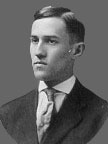
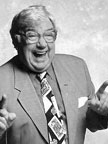 Calculating the bandwidth of a frequency modulated (FM) signal is a lot more complicated, however we should be eternally grateful for Carson's Rule, developed not by Northern Irish comedian Frank Carson but by American mathematician John Renshaw Carson. Carson did a lot of number-crunching to simplify things for us. His rule is this: If an RF carrier is frequency modulated with an AF signal which has a highest audio frequecy of B kHz with a deviation of D kHz, 99% of the resulting signal is contained in a radio bandwidth of 2(B+D) kHz. Deviation is the maximum distance that the signal moves from its centre frequency, so if our centre frequency is 5 MHz and this goes up to 5.05 MHz (and equally down to 4.95 MHz) when we apply the modulation, the deviation is 0.05 MHz or 50 kHz.
Calculating the bandwidth of a frequency modulated (FM) signal is a lot more complicated, however we should be eternally grateful for Carson's Rule, developed not by Northern Irish comedian Frank Carson but by American mathematician John Renshaw Carson. Carson did a lot of number-crunching to simplify things for us. His rule is this: If an RF carrier is frequency modulated with an AF signal which has a highest audio frequecy of B kHz with a deviation of D kHz, 99% of the resulting signal is contained in a radio bandwidth of 2(B+D) kHz. Deviation is the maximum distance that the signal moves from its centre frequency, so if our centre frequency is 5 MHz and this goes up to 5.05 MHz (and equally down to 4.95 MHz) when we apply the modulation, the deviation is 0.05 MHz or 50 kHz.Applying this practically, a mono FM broadcast has a highest audio frequency of 15 kHz and a deviation of 75 kHz, so the resulting FM signal has a bandwidth of 2*(15+75)=180 kHz. For stereo the audio bandwidth increases to 53 kHz (see this article) and so the resulting FM signal has a bandwidth of 2*(53+75)=256 kHz. For a CB radio the highest audio frequency is usually 3 kHz and the deviation just 2 kHz resulting an RF bandwidth of 2*(3+2)=10 kHz - which is why CB radio channels are spaced 10 kHz apart! See, there a reason for everything.
Friday 17 February, 2006, 13:34 - Spectrum Management
Ofcom recently organised a seminar concerning the forthcoming auction of a chunk of UHF spectrum covering the UK. The spectrum concerned is 412 - 414 MHz paired with 422 - 424 MHz which was previously the haunt of the UK Ministry of Defence (MoD). The MoD have now (largely) vacated this spectrum and Ofcom has decided that the best use for it is to sell it to the highest bidder along with the rights for the winning bidder to sell it on to whoever they fancy.Four blocks (the inventively named A, B, C and D) of 2 times 500 kHz are being offered, and bidders can bid for one or more of these blocks. The winning bidder(s) will be decided by a complex mathematical calculation to determine which combination of bids yields the maximum revenue to Ofcom.
 By way of an example, let's assume there are four bidders: Eric, Simon, Abby and Tamara. Eric offers GBP300,000 for all four blocks of spectrum. Simon wants 3 blocks and offers GBP200,000 for blocks A, B and C but is not interested in D. Abby wants only 1 block and offers GBP150,000 for any of them - A, B, C or D. Tamara wants two contiguous blocks and offers GBP250,000 for A&B, B&C or C&D. How do we decide the winner? Well in this situation, the maximum revenue that can be generated is if Simon gets blocks A, B and C and Tamara gets block D, yielding revenue of GBP350,000 for Ofcom. If, however, Tamara had only bid GBP100,000 for any block, there would have been a tie. Eric's offer of GBP300,000 for all 4 blocks would tie with a combination of Simon and Tamara's offers.
By way of an example, let's assume there are four bidders: Eric, Simon, Abby and Tamara. Eric offers GBP300,000 for all four blocks of spectrum. Simon wants 3 blocks and offers GBP200,000 for blocks A, B and C but is not interested in D. Abby wants only 1 block and offers GBP150,000 for any of them - A, B, C or D. Tamara wants two contiguous blocks and offers GBP250,000 for A&B, B&C or C&D. How do we decide the winner? Well in this situation, the maximum revenue that can be generated is if Simon gets blocks A, B and C and Tamara gets block D, yielding revenue of GBP350,000 for Ofcom. If, however, Tamara had only bid GBP100,000 for any block, there would have been a tie. Eric's offer of GBP300,000 for all 4 blocks would tie with a combination of Simon and Tamara's offers.The question was asked of Ofcom, "How will you decide between bidders in the event of a tie?" Ofcom's Director of Spectrum Markets, Graham Louth, a well-respected economist replied, "We have a Bingo machine". Highly complex calculations and then a Bingo machine, it's nice to know that UK Government departments use the latest technology, makes you much happier to pay all those juicy taxes.
Let's take a look at the spectrum on offer. In principle it's quite handy. Most modern UHF radios cover the range 400 to 470 MHz and could easily operate in this band. Further, this is one of the main bands in which digital TETRA radios are designed to operate. And if that's not enough, there are even CDMA networks designed to operate in this band. So there's no lack of available equipment. Ofcom are offering the spectrum on a technology neutral basis so any of these technologies could be deployed. Or could they...
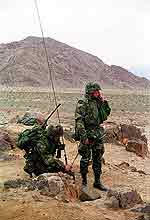 All is not quite as straightforward as it might at first seem. Remember I said earlier that the MoD have now largely vacated this band, well the fact is that there are still around 100 MoD frequency assignments (approximately half of them in Northern Ireland). Details of what and where these assignments are will be accessible to succesful bidders via a software tool that disguises the actual location of usage (for security reasons of course). Further, there are a handful of channels which are used, nationwide, by the MoD. Unless these assignments fall at the very edges of the band (unlikely), there would be insufficient spectrum to deploy cdma2000 which requires a clear block of about 1.5 MHz in order to function. When quizzed about this apparent contradiction to Ofcom's technology neutral stance, Graham Louth responded, "You are misconstruing what we mean by technology neutral". Is that so? cdma2000 can be deployed if you want to, but practically speaking it's impossible to do so. That's like saying, "You can cover this land I'm selling with a building as large as you like, however you mustn't disturb the herb gardens which I've scattered right across it. Oh, by the way, I'm not going to tell you where the herb gardens are until you buy the land".
All is not quite as straightforward as it might at first seem. Remember I said earlier that the MoD have now largely vacated this band, well the fact is that there are still around 100 MoD frequency assignments (approximately half of them in Northern Ireland). Details of what and where these assignments are will be accessible to succesful bidders via a software tool that disguises the actual location of usage (for security reasons of course). Further, there are a handful of channels which are used, nationwide, by the MoD. Unless these assignments fall at the very edges of the band (unlikely), there would be insufficient spectrum to deploy cdma2000 which requires a clear block of about 1.5 MHz in order to function. When quizzed about this apparent contradiction to Ofcom's technology neutral stance, Graham Louth responded, "You are misconstruing what we mean by technology neutral". Is that so? cdma2000 can be deployed if you want to, but practically speaking it's impossible to do so. That's like saying, "You can cover this land I'm selling with a building as large as you like, however you mustn't disturb the herb gardens which I've scattered right across it. Oh, by the way, I'm not going to tell you where the herb gardens are until you buy the land".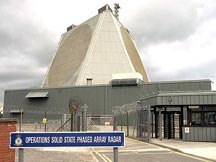 If that's not bad enough, the RAF Ballistic Missile Early Warning System (BMEWS) radar at Fylingdales in North Yorkshire uses the frequencies from 420 to 450 MHz and so the 422 - 424 MHz block can not be used within the vacinity of this station. The radar, which uses high powered radio transmissions to track incoming missiles, is also likely to cause severe interference over a wide swathe of Northern England. So now as well as the herb gardens, we've got industrial chimneys spewing out pollution over large areas of the land for sale. How come the chimneys don't already pollute the herb gardens, well they're owned by the same person of course - the MoD!
If that's not bad enough, the RAF Ballistic Missile Early Warning System (BMEWS) radar at Fylingdales in North Yorkshire uses the frequencies from 420 to 450 MHz and so the 422 - 424 MHz block can not be used within the vacinity of this station. The radar, which uses high powered radio transmissions to track incoming missiles, is also likely to cause severe interference over a wide swathe of Northern England. So now as well as the herb gardens, we've got industrial chimneys spewing out pollution over large areas of the land for sale. How come the chimneys don't already pollute the herb gardens, well they're owned by the same person of course - the MoD!Most likely someone will want to buy this spectrum; an auction for the same spectrum in the Republic of Ireland raised Euro215,007 for the Irish Government. However with so many holes and so much pollution in it, it will be interesting to see how much, or how little, the auction raises. I'll let you know.
Thursday 15 December, 2005, 02:00 - Spectrum Management
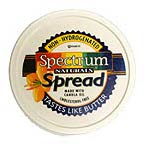 The concept of 'spread spectrum' dates back to World War II when the concept was put to use as countermeasures against jamming; against detection by radar; against detection of navigation beacons and as a way to make interception of communications more difficult. The idea is to take a signal and spread it across a much wider range of frequencies than the originating (data) signal would have otherwise occupied; indeed this is one of the two requirements of a system to be officially designated as spread spectrum. The other requirement is that some function of the original data signal has an impact on the final spread spectrum signal - a technicality that we won't bother with here as it's not relevant to the ensuing discussion.
The concept of 'spread spectrum' dates back to World War II when the concept was put to use as countermeasures against jamming; against detection by radar; against detection of navigation beacons and as a way to make interception of communications more difficult. The idea is to take a signal and spread it across a much wider range of frequencies than the originating (data) signal would have otherwise occupied; indeed this is one of the two requirements of a system to be officially designated as spread spectrum. The other requirement is that some function of the original data signal has an impact on the final spread spectrum signal - a technicality that we won't bother with here as it's not relevant to the ensuing discussion.But what is the point of this? Why occupy more spectrum than is necessary? Isn't this a highly inefficient use of spectrum?
Well spreading a signal has two noticeable effects:
1. It makes the signal much more difficult to detect;
2. It makes the signal much less susceptible to narrow-band interference (such as traditional jamming signals).
Clearly these effects have immediate military connotations and it is no surprise that (as with many other radio techniques) the idea was first put to use in this context, however these effects also have great benefits for other uses too. Let's examine them one by one.
Reduced likelihood of detection
 From a civil perspective, reducing the likelihood that your transmissions will be heard isn't of major concern except perhaps in public telecommunications networks, however the use of encryption is a much more straightforward way of going about making your transmissions private. For 'reduced likelihood of detection' we could alternatively write 'reduced likelihood of causing interference', as if a signal is difficult to detect, it is unlikely to cause interference to another transmission. In fact, all modern cellular phone networks use some kind of spread spectrum technique to try and reduce the interference that a handset communicating with one base-station causes to other base-stations in the network. Also, for technologies such as Wireless LAN and Bluetooth where many users share the same piece of spectrum, using spread spectrum techniques vastly reduces the probability of users causing each other interference.
From a civil perspective, reducing the likelihood that your transmissions will be heard isn't of major concern except perhaps in public telecommunications networks, however the use of encryption is a much more straightforward way of going about making your transmissions private. For 'reduced likelihood of detection' we could alternatively write 'reduced likelihood of causing interference', as if a signal is difficult to detect, it is unlikely to cause interference to another transmission. In fact, all modern cellular phone networks use some kind of spread spectrum technique to try and reduce the interference that a handset communicating with one base-station causes to other base-stations in the network. Also, for technologies such as Wireless LAN and Bluetooth where many users share the same piece of spectrum, using spread spectrum techniques vastly reduces the probability of users causing each other interference.Of course spread spectrum is not the panacea of interference mitigation as if two spread spectrum signals of the same type and on the same frequency clash they still cause each other interference, but it can go a long way to reducing interference between users, especially in de-regulated radio environments where it's 'every user for themselves'.
Reduced suscepitibility to narrow-band interference
Spreading a signal across a wide-range of frequencies means that the amount of information transmitted in any portion of those frequencies is only a fraction of the overall information being transmitted. As such, if a portion of the spread signal is interfered with, the received data will only be fractionally affected and with data correction techniques it is possible to stop narrow-band signals from interfering with spread spectrum signals at all. Of course one spread spectrum signal could easily interfere with another using the same frequencies as if all the frequencies in use are affected there is generally no way to 'tune-out' the interfering signal.
Spread spectrum systems are therefore largely immune to narrow-band interference such as might be caused by traditional AM or FM signals. As well as the obvious anti-jamming military uses, this still has great benefit in a civil situation where a system has to share spectrum with lots of potentially interfering sources.
Spread Spectrum Techniques
There are two commonly deployed spread-spectrum techniques plus two uncommon ones:
 Frequency Hopping Spread Spectrum (FHSS) is a commonly deployed technique whereby a signal changes frequency or 'hops' (usually very rapidly) across a wide band of available frequencies. The receiver has to be synchronised with the transmitter so that it knows what hopping pattern to follow. If a few of the frequencies onto which the system hops have interference, the overall transmission will still be received as communication continues takes places on the clear frequencies (indeed some systems are intelligent and cease to use frequencies on which interference is present).
Frequency Hopping Spread Spectrum (FHSS) is a commonly deployed technique whereby a signal changes frequency or 'hops' (usually very rapidly) across a wide band of available frequencies. The receiver has to be synchronised with the transmitter so that it knows what hopping pattern to follow. If a few of the frequencies onto which the system hops have interference, the overall transmission will still be received as communication continues takes places on the clear frequencies (indeed some systems are intelligent and cease to use frequencies on which interference is present). Hopping across a wide range of frequencies has one additional benefit: the propagation conditions on one frequency will be different to those on another frequency, such that, especially in mobile environments, FHSS signals provide a way to mitigate against the frequency selective fading that occurs. Even changes in frequency of a few percent can be useful and this is one of the main reasons that GSM networks often employ FHSS from the handsets. Bluetooth also uses FHSS but in this case to dodge between the large number of interfering signal that appear in the shared frequency band it inhabits.
Direct Sequence Spread Spectrum (DSSS) is a commonly deployed technique whereby a radio signal is spread by mixing it with a high bit-rate data spreading signal. At the receiver, the same spreading signal can be used to 'de-spread' the received signal and return it to its original state. This de-spreading results in any narrow-band interference being spread and effectively turned into background noise. Equally, the effect of frequency selective fading (as found in mobile environments) is to null out reception on some frequencies. with DSSS these nulls will be spread to appear as 'anti-noise', or in other words, a small reduction in the overall reveived signal.
Unlike FHSS signals which only occupy one frequency at once, DSSS signals occupy all the frequencies over which they have been spread at the same time. CDMA systems use DSSS, as do Wireless LAN's conforming to many of the 802.11 series of standards.
Chirp is an uncommon technique in which a transmission begins on one frequency and ends on another, changing from one to the other during the period of the transmission. It is difficult to receive such signals as almost perfect synchronisation is needed between receiver and transmitter in terms of time and frequency, however with modern signal processing techniques it is becoming possible.
Chirp, however, is often used for radar systems as it is a spectrally efficient way of generating the wide-bandwidth transmissions that are required to ensure the accuracy of the radar.
Time Hopping Spread Spectrum (THSS) is an undeveloped technique in which, the transmitted signal is turned on and off in a psuedo-random fashion (thus hopping on and off with time). Interest has been raised in this technique as a method for sharing spectrum for Ultra Wide Band devices.
Spread spectrum techniques are now a part of every-day radio usage both for military and civil systems and are allowing more effective use of spectrum to be made as well as providing a means of using otherwise difficult to use spectrum (such as that shared with microwave ovens). What will be the next military technique to make the cross-over to every-day civil usage?

